
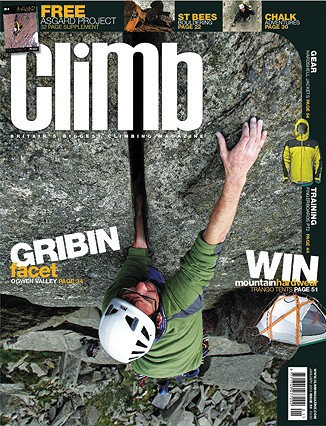

Take a look inside the January 2010 issue of Climb Magazine. Great articles on Griben Facet and St Bees (seaside bouldering) plus there's a great FREE 32 page A5 Asgard Supplement with this issue! You can also enter our fantastic competition to win one of three Mountain Hardwear Trango 2 Tents (worth £500). Climb Magazine is available in WHSmith stores, specialist retailer outlets and climbing walls. You can subscribe online at www.climbmagazine.com or pick up a copy at your newsagents or at your local climbing shop. We've also got a digital teaser of the magazine this month at www.climbmagazine.com
St. Bees
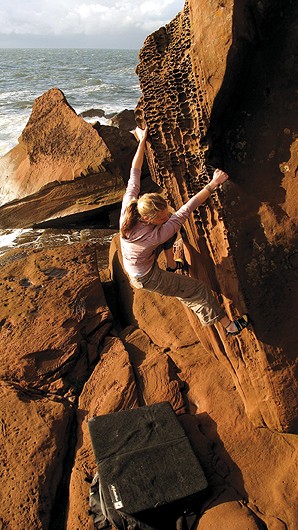
Every so often you find yourself at a climbing venue that seems so disconnected from the norm that you have to remind yourself that you are still in Blighty.
St Bees definitely falls into that category.
It seems remote and detached from reality, certainly alien to our perceptions of quintessential British bouldering. How often do you find yourself climbing on the beach, hearing the waves lap or crash at the shore, whilst climbing some of the most beautifully contoured and coloured rock this country has to offer? Being predominantly a boulderer, I can safely say “not that often”.
Swarms of climbers are rare. So, for the climber seeking solitude but without compromising the quality of the venue St Bees may be your 'honey pot'. hunks of honey-hued sandstone rest on a smoothly-weathered plateau, framed by the soaring sea cliffs and the vast expanse of ocean. On a crisp clear, day I doubt there is a more glorious backdrop for climbing.
However, it is the wild and tempestuous days which offer the most gratifying adventures. The crashing waves and blustery winds overwhelm the senses and give the impression of total wilderness, heightening the satisfaction of climbing.
Chalk

My first visit to 'the chalk' wasn't particularly memorable in terms of climbing. We only managed a brief bit of bouldering at Saltdean but it was the only time I've been ogled by passing members of the public more than my female climbing partner. Not that that should be a reflection on Kath who usually turned heads at every other crag we visited but more due to the kind of audience that was attracted to the nearby nude sunbathing beach that was so popular with Brighton's gay community.
My second visit was a little more substantial when Chris Cubitt and I repeated The Great White Fright over a couple of days. This three pitch prow wouldn't have been most folk's choice as their first route on chalk but I'd been seduced by the stunning shots of Phil Thornhill on the final pitch.
The constant patter of raining chalk fragments was only interrupted by the thunder of larger sections of the cliff tumbling into the Channel, my whimpers as loc-tite cramps played havoc with my wilting swing and Chris's unique celebration (enough to make those Saltdean sunbather's blush) as we finally hauled ourselves over the top. All in all not very pretty!
Chalk is like all proper adventures whose true value needs at least a few weeks to mature. Once the terror subsides, the one or two 'good moments' shine through in a rose-tinted haze blocking the numerous darker times and eventually the sheer relief of survival is replaced by a nagging urge to return.
And I guess that is how I found myself once again making the six hour drive south with my axes one winter's day instead of north to Scotland.
I'd also brought along a couple of lemmings... oh er... accomplices, in the shape of Jon Winter and Paul Winder. Somehow they'd been persuaded that whilst chalk might not look normal it offered a classic British day out that all 'proper' climbers should experience at least once in their lifetime. Where exactly this classic was going to be found along the four miles of tottering choss at Dover I wasn't sure.
'How's it going Paul?' I shouted, mainly to let him know I was still awake. 'Not good,' came the reply, 'it's like the hanging gardens of Babylon up here.
'Shit,' I muttered to myself. It looked like an impasse. He'd been making good progress along the diagonal crack; the rock was a bit dirty, but still climbable. Now the ropes hadn't moved for ten minutes and it was clear we were not going to finish this route. He'd done most of the difficult climbing and was only a short way from the top, but encroaching vegetation had swallowed the last few metres of the pitch, making it unclimbable. I looked down at my feet to ease my aching neck. The only sounds were the scrapings of Paul's nut key probing for gear placements
under the greenery, his occasional coughs when dust from dried-up moss caught in his throat, and the faint cry of the peregrine. 'Nobody's been up here for years,' floated down on the warm evening airs, 'I'll have to come down.' I thought quickly: it's too good a pitch to let nature take its course any further, but heavy gardening could upset the environmental lobby. What other options are there? 'That spike - can you lower off it?'
'Yes, but what about the gear?'
'I'll follow and take it out, then you can lower me off.'
Of all outdoor gear it is hardshells that have maybe been the most subject to incomprehensible, even misleading
marketing jargon and hype. Of course the term hardshell itself is an example of the problem.
Hardshells are neither hard, nor very much like a shell (ask any snail). So for clarification this month I'm discussing jackets that are designed to keep the weather out when you are climbing and/or in the mountains. BREATHABILITY
All such jackets are claimed to be waterproof, windproof and breathable. To take this last term first - fabrics can not breathe, only lungs can. So-called 'breathable' fabrics use a variety of materials and methods of construction to aid the passage of moisture, created by sweating, from the inside of the jacket to the outside air, whilst remaining water and windproof from the outside. It's a tall order and there is an amazing amount of quite fancy science involved. But breathing it ain't.
If you are interested in such things, 'breathability' is measured in two ways. Firstly as how much vapour a square metre of fabric will allow to pass through in 24 hours (gm/m2/24hr). The second method as I understand used by Gore amongst others is RET (evaporative resistance of a textile). The lower the RET score, the better the better breathability. Low breathability doesn't matter much if you aren't generating much sweat. Climbing and mountaineering however pose particular problems as they often have periods of very high followed my very little exertion during which sweat needs to evaporate fast to avoid chilling (and I'm not talking about when you are in the pub). High levels of both breathability and weatherproofing are needed.
'Oh - you mean like sports climbing without the bolts?' 'Err, yeah, sort of.' The route was Throsher on the East Buttress; when it was first climbed in 1970, it topped out in the normal way, but as in life, nothing stays the same for ever. That's the fascination of guidebook work: you never know what surprises you'll run into; when you'll spot an unrecognised gem of a route, or best of all, an unclimbed line.
There are still a few unclimbed lines on the Gribin Facet if you know where to look. This wasn't one of them, but still a worthwhile pitch, with steep climbing that makes you work for every move. In a way it's typical of the place.
It's a modest little crag: a broad low sprawl of rock with seemingly jumbled architecture. At a casual glance from the Cwm Idwal track you are tempted to ignore it, seduced by the prospect of the great sweep of rock rising from the shore of Llyn Idwal to the Glyder Fawr skyline, or the appeal of the East Buttress on Glyder Fach's Main Cliff.
Mountain INFO is now exclusively available on-line via the Climb Magazine website FREE!! This internationally acclaimed resource has been added to our extensive online 'Archives' as a fully downloadable pdf. You will be able to view and print off Mountain INFO at the touch of a button, 24/7 via the Climb website at www.climbmagazine.com For over 35 years Mountain INFO has been the essential place to research Alpinism, big walls and mountaineering expeditions throughout the world. An intrinsic part of Climb Magazine, Mountain INFO is edited by the well known and respected mountaineer, Lindsay Griffin, who uses his worldwide contacts, built up over many years - to bring first-class information and quality images to you. Now, to enable you to access this massive resource more easily we are making it freely available online. Search for places of interest to plan your next expedition and keep yourself up-to-date with what is happening in the world of mountaineering. Log on and access every Mountain INFO published in Climb Magazine since March 2005. As with all of our 'Archives', we will continue to add to this section, eventually including the early days of High Mountain Sports. Subscribe online at www.climbmagazine.com We are offering all UKClimbing.com readers the opportunity to benefit from special reduced rates when subscribing to Climb Magazine. For a limited period only you can save a massive £29.00!* Exclusive Discounted Rates In order to qualify for these special rates simply log onto the Climb website and enter the following promo codes: Subscribe online at www.climbmagazine.com
WEATHERPROOF JACKETS - HARDSHELLS?
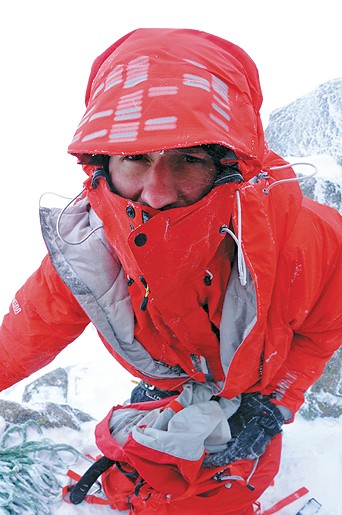
Griben Facet
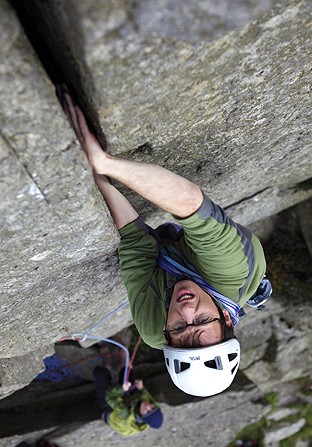
FREE Mountain INFO downloads at Climb Magazine

UKCLIMBING.COM READER SUBSCRIPTION OFFER
1 yr (12 issues) RRP £42.00 - UKC Special Rate £30.00
2yr (24 issues) RRP £84.00 - UKC Special Rate £55.00
1yr - EARLYUKONE
2yr - EARLYUKTWO
* Based upon a UK 2yr subscription.
* Overseas readers can also benefit from the offer – simply contact [email protected] for your unique promo code.










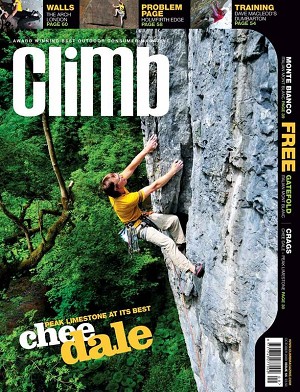









Comments